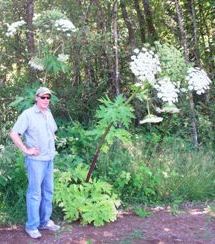 Giant Hogweed (photo from the King County, Washington, web site) |
The Finger Lakes Trail Conference reports a stand of Giant Hogweed along Spencer Hill Road, near Hornell, New York, on map M10.
Hogweed, Heracleum mantegazzianum, is similar to the very large Cow Parsnip, but is even larger. The sap of the plant causes severe skin burns. It can grow to 15 feet, with leaves spanning 2-5 feet. The thick stem has mottled purple areas. The stem, leaf and flower stalks are hairy. It has small white flowers in big clusters, looking like Queen Anne's Lace. Originally brought from Asia as an ornamental, it has escaped into many natural areas.
Steve Catherman, of the Steuben County DPW reports: "We are currently dealing with Giant Hogweed issues around our roads, trails, and bridges. In fact, a consultant bridge inspector came into contact with it while inspecting one of our bridges and had to be hospitalized with severe 'burns' that may [leaves scars which can] be permanent."
If you see this plant, do not attempt to remove it. Contact a plant professional! Cutting, mowing, or injuring the plant in any way will release the sap. Sap on skin, when exposed to sunlight results in the blistered burns which can be extremely serious.
If contact is made, wash immediately with soap and water and seek medical attention.
See New York State Health Department information about Giant Hogweed
See King County, Washington information about Giant Hogweed




























No comments:
Post a Comment